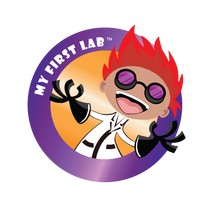
How To Choose The Perfect Microscope
How To Choose The Perfect Microscope
Picking out the perfect microscope can be a difficult decision. My First Lab has various models, each providing a valuable examination of the world around us.
When it comes to choosing a microscope, ask yourself:
- What do you want to view?
- What field are you interested in?
- Which features do you enjoy?
Today, My First Lab will walk you through our microscope models and which science fields utilize them.
TABLE OF CONTENTS
- Biology Microscopes
- Stereo Microscopes
- Ocular Tube Count- All the Better to See With
- Browse Our Product Page
- My First Lab’s Mission

Biology Microscopes
When you imagine a microscope, a biology microscope is usually the model that comes to mind. These microscopes have a variety of ocular tubes, a bottom light, and a short distance from the stage to the objective lens.
The stage is the microscope part you place your sample on for viewing. The objective lens is closest to the sample and acts as a magnifying glass to enlarge the image.
In professional settings, these can be called Compound Microscopes. They’re great for high magnifications for viewing samples of cells or tissues because, in addition to their intense visuals, they also offer clear images. The bottom light passes through the samples on the stage, allowing users to see what is usually invisible to the eye.
Find Your Perfect Microscope at MFL: Biology Microscopes:
- MSK-01L Student Microscope w/ LED & mechanical stage
- MFL-05 Ultimate Microscope
- MFL-06 Duo Scope
- MFL-20 Duo Scope Starter Kit
- MFL-26 Mega Duo Scope
Fields that Use Biology Microscopes
Biology, forensics, oceanography, and botany are some fields that use Biology Microscopes.
Stereo Microscopes
If Compound Scopes take the prize for resolution and objectives, Stereo Scopes win stage space. These microscopes have lower magnification power, but the distance between the stage and objectives makes them perfect for larger 3D samples like rocks, bugs, or circuit boards. Unlike the biology microscope, the lighting system on a Stereo Scope comes from the top light, thus highlighting details of objects that are solid.
Find Your Perfect Microscope at MFL: Stereo Microscopes
Fields that Use Stereo Microscopes
Some fields that use Stereo Microscopes include geology, gemology, engineering, wildlife biology, microbiology, and endocrinology.
Ocular Tube Count – All the Better to See With
Monocular
These scopes are perfect for at-home labs or educational settings, such as the classroom. This model will have a singular eye tube with one eyepiece. Monocular scopes can also accommodate digital camera ports to view and share sample images.
Binocular
These models will have two eyepieces and eye tubes. Due to their dual nature, these models can be more comfortable for extended observations. As a result of their long-duration use, researchers and educators use binocular scopes.
Trinocular
We don’t have three eyes, so why should our microscope have three eye tubes? Trinocular scopes are for users to combine with a digital camera. Using the third port, users can put a microscope camera in to view their samples on a big screen or share them across other platforms. This microscope is handy for researchers and educators as well.
Browse Our Product Page Today to Find Your Perfect Microscope
My First Lab offers several professionally designed models in the above styles. Browse our collection of microscopes and accessories here. If you’re new to microscopes and want a catch-all model that captures the best of both types, check out My First Lab’s Duo Scope.
My First Lab’s Mission
My First Lab helps kids discover, learn, and grow. We believe that STEM education has the power to spark curiosity in students of all ages. Our devices are top-of-the-line, affordable, portable, and functional for all learners and educators. To learn more about who we are and what we do, visit our About Us section.
My First Lab has led in developing STEM equipment for the past 30 years. With products ranging from microscopes and bundles to prepared slides and accessories, we will have any product that a junior investigator, hobbyist, or educational leader could need. Learn how to create hands-on experiments by browsing our blog or checking out our award-winning products.









